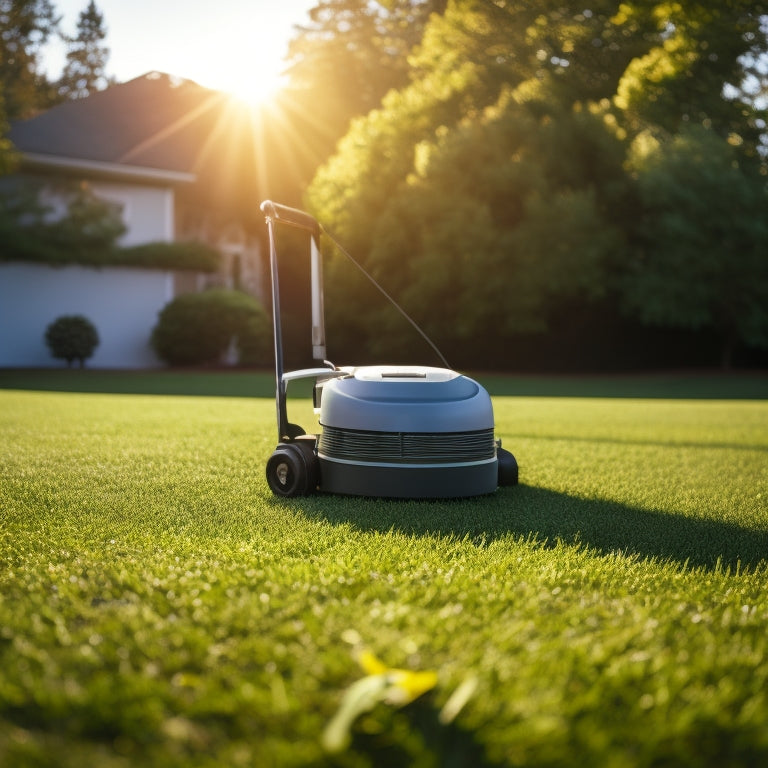
Green Lawn Care: Top Electric Dethatchers Reviewed
Share
You're looking for a reliable electric dethatcher that can help you achieve a lush, green lawn while minimizing your environmental footprint. From top-rated picks like the GreenWorks G-MAX 40V and Sun Joe AJ801E, you'll find eco-friendly options that prioritize healthy growth and air circulation. When selecting an electric dethatcher, consider key features like adjustable tine depth, power, and speed to tackle thick thatch. By understanding how electric dethatchers work and their benefits, you'll be well-equipped to choose the best model for your lawn. Now, investigate further to uncover more about the top electric dethatchers and take the first step towards a greener, healthier lawn.
Key Takeaways
- Top electric dethatchers are eco-friendly, efficient, and suitable for small to medium-sized lawns, promoting healthy growth and air circulation.
- Key features to consider include power, speed, adjustable settings, collection bags, and foldable designs for optimal performance and storage.
- Electric dethatchers work by rotating flails or tines to remove thatch, enhancing water penetration, nutrient uptake, and lawn resilience against diseases and pests.
- Maintenance and safety tips include regular cleaning, blade inspection, and storage in a dry area to ensure equipment longevity and peak performance.
- When selecting an electric dethatcher, consider durability, efficiency, warranty, and support from manufacturers for a long-term investment and reliable performance.
Top Electric Dethatcher Picks
When you're in the market for a reliable electric dethatcher, choosing the right one can be overwhelming. You need a tool that can effectively remove thatch and debris, promoting healthy lawn growth and improving overall lawn care.
With the growing demand for sustainable practices, it's crucial to evaluate eco-friendly options, such as solar-powered charging solutions, which can reduce carbon footprint and energy costs.
For ideal dethatching techniques, contemplate the GreenWorks G-MAX 40V Cordless Dethatcher, which boasts a powerful 40V motor and adjustable tine depth. Alternatively, the Sun Joe AJ801E 13-Amp Electric Dethatcher offers a sturdy 13-amp motor and 12.6-inch dethatching width.
Both models are designed for efficient lawn maintenance and are suitable for small to medium-sized lawns. Research these top picks to find the best fit for your lawn care needs and take the first step towards a lush, thriving lawn.
Benefits of Electric Dethatching
By investing in an electric dethatcher, you're taking a significant step towards a healthier, more lively lawn. This is because electric dethatching techniques promote lawn health by removing dead grass and debris, allowing air, water, and nutrients to reach the soil.
As a result, your lawn will be more resilient to disease and pests, and it will require less maintenance in the long run. Additionally, by adopting eco-friendly practices like using renewable energy sources for EV charging sustainable road trip amenities, you're contributing to a greener environment.
-
Improved air circulation: Electric dethatching helps to remove thatch, a thick layer of dead grass and debris that can choke your lawn, allowing air to circulate and reach the soil.
-
Enhanced water penetration: By removing thatch, electric dethatching guarantees that water can penetrate the soil more easily, reducing runoff and promoting healthy root growth.
-
Boosted nutrient uptake: Electric dethatching allows nutrients to reach the soil, promoting healthy plant growth and development.
How Electric Dethatchers Work
Across your lawn, electric dethatchers operate by leveraging their rotating flails or tines to tear away thatch, a thick, dead layer of grass and debris that can choke your lawn.
These dethatching techniques effectively remove dead material, promoting healthy growth and airflow. As you use an electric dethatcher, the flails or tines spin at high speed, cutting through the thatch and lifting it out of the lawn.
By adopting sustainable practices, such as integrating renewable energy solutions into your lawn care routine, you can greatly reduce your carbon footprint.
This process not only improves lawn health but also enhances its appearance, allowing you to enjoy a lush, green space. By removing the dead layer, you're giving your lawn the freedom to breathe, absorb water, and receive essential nutrients, ultimately leading to a thriving and resilient lawn.
Key Features to Consider
As you prepare to invest in an electric dethatcher, understanding the key features to consider is essential to making an informed decision. You want a machine that will effectively improve your lawn health without breaking the bank or requiring too much storage space.
When evaluating your options, think about the long-term savings you could achieve by reducing your electricity bills and carbon footprint, much like solar-powered stations can do for commercial EV charging.
When choosing an electric dethatcher, consider the following:
-
Dethatcher types: Do you need a vertical cutter, power rake, or tow-behind model? Each type is suited for specific lawn conditions and sizes.
-
Power and speed: How much power do you need to tackle thick thatch or dense grass? Look for a dethatcher with adjustable speed settings for maximum performance, considering the complexity and accessibility of your lawn, similar to how installation costs for commercial EV charging stations vary.
-
Additional features: Do you want a machine with a collection bag, adjustable handle, or foldable design for easy storage?
Product Reviews and Ratings
With your key features in mind, it's time to plunge into the top electric dethatcher models on the market, putting their performance and value to the test.
Regular maintenance and inspections, as seen in fleet maintenance schedules, are essential in ensuring the longevity of your equipment.
You'll want to examine user experiences and product comparisons to get a clear understanding of each model's strengths and weaknesses.
Look for reviews that highlight the dethatcher's effectiveness in removing thatch, ease of use, and durability.
Compare the power and speed of different models, as well as their ability to handle varying lawn sizes and types.
Environmental Impact Reduction
Your lawn's health is directly tied to the environmental impact of your dethatching routine. By switching to an electric dethatcher, you're already taking a step in the right direction.
However, there are more ways to reduce your environmental footprint.
-
Opt for eco-friendly materials: Look for dethatchers with sustainable materials, such as recycled plastics or biodegradable components.
-
Adopt sustainable practices: Regularly maintain your dethatcher to guarantee peak performance and reduce energy consumption.
-
Properly dispose of waste: Compost or recycle the thatch and debris collected during dethatching to minimize landfill waste.
Maintenance and Safety Tips
Regular maintenance is essential to extending the lifespan of your electric dethatcher and guaranteeing peak performance. You'll want to perform routine checks and tasks to keep your device running smoothly and safely.
| Task | Frequency | Why |
|---|---|---|
| Clean the dethatcher | After each use | Remove debris and grass clippings to prevent damage |
| Check and replace worn blades | Every 2-3 months | Maintain effectiveness and prevent damage to underlying soil |
| Inspect and clean air vents | Monthly | Guarantee proper airflow and prevent overheating |
| Store in a dry, protected area | After each use | Prevent rust and water damage |
| Review user manual | Annually | Stay up-to-date on safety precautions and maintenance guidelines |
Best Value for Your Money
When selecting an electric dethatcher, you're likely looking for a device that not only gets the job done but also provides the best value for your hard-earned money.
You want an affordable option that won't break the bank, yet still delivers quality results. A good electric dethatcher should be a long-term investment, providing reliable performance for years to come.
Here are three key factors to evaluate when searching for the best value:
-
Durability: Look for a dethatcher with a sturdy build and high-quality components that can withstand regular use.
-
Efficiency: Opt for a device with a high dethatching rate and adjustable settings to guarantee you get the job done quickly and effectively.
-
Warranty and Support: Choose a manufacturer that offers an extensive warranty and reliable customer support to make certain you're protected in case anything goes wrong.
Frequently Asked Questions
Can I Use an Electric Dethatcher on Newly Seeded or Sodded Lawns?
Coincidentally, you're wondering if it's safe to dethatch newly seeded or sodded lawns. You shouldn't, as it can damage tender seedlings. Wait until they're established, typically 6-8 weeks, to guarantee seedling protection and ideal dethatching timing.
How Often Should I Dethatch My Lawn to Maintain Its Health?
You should dethatch your lawn annually, or bi-annually for heavily thatched areas, to maintain ideal lawn health; adjusting dethatching frequency based on factors like climate, soil type, and grass species guarantees a thriving, low-maintenance lawn.
Are Electric Dethatchers Suitable for Small or Large Lawn Areas?
When considering an electric dethatcher, you'll want to assess your lawn size and the tool's efficiency; for small to medium-sized lawns, electric dethatchers are ideal, but for larger areas, you may need a more powerful, gas-powered option or divide the job into manageable sections.
Can I Use an Electric Dethatcher on Steep or Sloping Lawns?
When tackling steep or sloping lawns, you'll need to prioritize dethatcher safety, considering lawn slope considerations to avoid accidents; look for models with adjustable handles, wide wheels, and sturdy construction to guarantee stable operation and best results.
Do Electric Dethatchers Work Well on Thick or Dense Thatch Layers?
As you engage in thatch removal, you'll find electric dethatchers can tackle thick, dense layers, but their effectiveness depends on the tool's power, tine design, and your lawn's specific needs, making lawn aeration an essential step in the process.
Related Posts
-

10 Best WiFi Outlets for Tracking Home Energy Usage
You can optimize your home's energy usage with the right WiFi outlets, which provide real-time monitoring and control...
-

How to Upgrade Your Home With Geothermal Innovations
You're now on the cusp of utilizing the Earth's natural thermal energy to revolutionize your home's heating and cooli...
-

Why Biodegradable Dish Soap Matters for Earth-Conscious Homes
You likely don't realize that the dish soap you're using today will still be harming the environment long after you'v...


